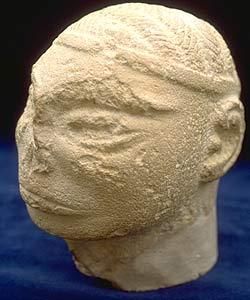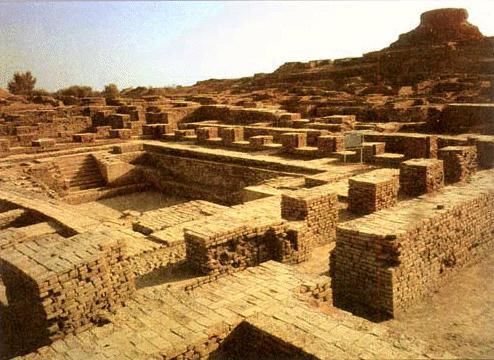
The African Presence in India:
(Part One)
An Historical Overview

In Greater India, more than a thousand years before the foundations of Greece and Rome, proud and industrious Black men and women known as Dravidians erected a powerful civilization. We are referring here to the Indus Valley civilization- -India's earliest high-culture, with major cities spread out along the course of the Indus River. The Indus Valley civilization was at its height from about 2200 B.C.E. to 1700 B.C.E. This phase of its history is called the Harappan, the name being derived from Harappa, one of the earliest known Indus Valley cities.
In 1922, about 350 miles northeast of Harappa, another large Indus city, Mohenjo-daro (the Mound of the Dead) was identified. Mohenjo-daro and Harappa were apparently the chief administrative centers of the Indus Valley complex, and since their identification, several additional cities, including Chanhu-daro, Kalibangan, Quetta and Lothal have been excavated.
The Indus cities possessed multiple level houses enhanced by sophisticated wells, drainage systems and bathrooms with flushing toilets. A recognized scholar on the Indus Valley civilization, Dr. Walter Fairservis, states that the "Harappans cultivated cotton and perhaps rice, domesticated the chicken and may have invented the game of chess and one of the two great early sources of nonmuscle power: the windmill."
The decline and fall of the Indus Valley civilization has been linked to several factors, the most important of which were the increasingly frequent incursions of the White people known in history as Aryans--violent Indo-European tribes initially from central Eurasia and later Iran. Indeed, the name Iran means the "land of the Aryan."
Ancient Africa and Early India
Exceptionally valuable writings reflecting close relationships between Africa and early India have existed for more than two thousand years. In the first century B.C.E., for example, the famous Greek historian Diodorus Siculus penned that, "From Ethiopia he (Osiris) passed through Arabia, bordering upon the Red Sea as far as India.... He built many cities in India, one of which he called Nysa, willing to have remembrance of that (Nysa) in Egypt, where he was brought up."
Another important writer from antiquity, Apollonius of Tyana, who is said to have visited India near the end of the first century C.E., was convinced that "The Ethiopians are colonists sent from India, who follow their forefathers in matters of wisdom." The literary work of the early Christian writer Eusebius preserves the tradition that, "In the reign of Amenophis III [the mighty Dynasty XVIII Egyptian king] a body of Ethiopians migrated from the country about the Indus, and settled in the valley of the Nile." And still another document from ancient times, the Itinerarium Alexandri, says that "India, taken as a whole, beginning from the north and embracing what of it is subject to Persia, is a continuation of Egypt and the Ethiopians."
Write your awesome label here.
India's Earliest Civilization

In Greater India, more than a thousand years before the foundations of Greece and Rome, proud and industrious Black men and women known as Dravidians erected a powerful civilization. We are referring here to the Indus Valley civilization- -India's earliest high-culture, with major cities spread out along the course of the Indus River. The Indus Valley civilization was at its height from about 2200 B.C.E. to 1700 B.C.E. This phase of its history is called the Harappan, the name being derived from Harappa, one of the earliest known Indus Valley cities.
In 1922, about 350 miles northeast of Harappa, another large Indus city, Mohenjo-daro (the Mound of the Dead) was identified. Mohenjo-daro and Harappa were apparently the chief administrative centers of the Indus Valley complex, and since their identification, several additional cities, including Chanhu-daro, Kalibangan, Quetta and Lothal have been excavated.
The Indus cities possessed multiple level houses enhanced by sophisticated wells, drainage systems and bathrooms with flushing toilets. A recognized scholar on the Indus Valley civilization, Dr. Walter Fairservis, states that the "Harappans cultivated cotton and perhaps rice, domesticated the chicken and may have invented the game of chess and one of the two great early sources of nonmuscle power: the windmill."
The decline and fall of the Indus Valley civilization has been linked to several factors, the most important of which were the increasingly frequent incursions of the White people known in history as Aryans--violent Indo-European tribes initially from central Eurasia and later Iran. Indeed, the name Iran means the "land of the Aryan."
Dravidian Kingdoms of South India
It is safe to say that when we speak of the Dravidians as a people we are speaking of the living descendants of the Harappan people of the ancient Indus Valley who were pushed into South India as the result of the Aryan invasions. This is certainly consistent with Dravidian traditions which recall flourishing cities that were either lost or destroyed in antiquity. The term "Dravidian," however, encompasses both an ethnic group and a linguistic group. The ethnic group is characterized by straight to wavy hair textures, combined with Africoid physical features. In reference to this Dr. Cheikh Anta Diop stated that: "There are two well-defined Black races: one has a black skin and woolly hair; the other also has black skin, often exceptionally black, with straight hair, aquiline nose, thin lips, an acute cheekbone angle. We find a prototype of this race in India: the Dravidian. It is also known that certain Nubians likewise belong to the same Negro type...Thus, it is inexact, anti-scientific, to do anthropological research, encounter a Dravidian type, and then conclude that the Negro type is absent."
Dravidian, in addition to its ethnic component, however, is an important family of languages spoken by more than a hundred million people, primarily in South India. These languages include Tamil (the largest element), Kannada, Malayalam (from which the name of the Asian country Malaya is derived), Telegu and Tulu. The term "Dravidian" itself is apparently an Aryan corruption of Tamil.
From at least the third century C.E. three major Dravidian kingdoms existed in South India: the kingdoms of Pandya, Chera and Chola. Pandya was the southernmost Dravidian kingdom. The major city of Pandya was Madurai, the location of the famous chapel of the Tamil Sangam (Academy). The Sangam, of which there were three, was initiated by a body of forty-eight exceptionally learned scholars who established standards over all literary productions. The Pandyan rulers received these intellectuals with lavish honors.
It is also important to note that in the kingdom of the Pandyas women seem to have enjoyed a high status. This is the exact opposite of the regions of India where the Whites ruled. In these lands of Aryan domination it is said that a woman was never independent. "When she is a child she belongs to her father. As an adult when she marries she belongs to her husband. If she outlives her husband she belongs to her sons." An early queen of the Pandyas, on the other hand, for example, is credited with controlling an army of 500 elephants, 4,000 cavalry and 13,000 infantry.
In 1288 and again in 1293 the Venetian traveler Marco Polo visited the Pandyan kingdom and left a vivid description of the land and its people. Polo exclaimed that:
"The darkest man is here the most highly esteemed and considered better than the others who are not so dark. Let me add that in very truth these people portray and depict their gods and their idols black and their devils white as snow. For they say that God and all the saints are black and the devils are all white. That is why they portray them as I have described."
To the northwest of Pandya was the kingdom of Chera (present-day Kerala). Northwest of Pandya lay the kingdom of Chola, said to be the place where Saint Thomas the Apostle was buried. The same Marco Polo who visited Pandya referred to Chola as "the best province and the most refined in all India."
The Dravidians were an unusually advanced seafaring people, with the Cholas, in particular, distinguishing themselves amongst the dominant maritime powers of their era. Through its ports, the great kings of Chola traded with Ethiopia and Somalia, Iran and Arabia, Combodia and China, Sumatra and Sri Lanka, exporting spices and camphor, ebony and ivory, quality textiles and precious jewels.
It seems readily apparent that the Dravidian kingdoms and the Dravidian people were quite well known internationally. When Augustus became head of the Roman world, for example, the Dravidian kingdoms sent him a congratulatory embassy. Dravidian poets describe Roman ships, which carried bodyguards of archers to ward off pirates, while the Dravidian kings themselves employed bodyguards of Roman soldiers. In respect to the ancient East, at least one author has identified a Dravidian presence in the Philippines, noting that: "From India came civilized Indians, the Dravidians from whom the savage Aryans learned. They began at least 500 BC and soon controlled the coast."


